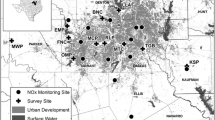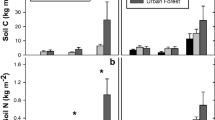Abstract
Plant–environment interactions are difficult to study in urban areas, in part due to the confounding factors that affect physiology, including alterations to atmospheric composition and climate. We wished to determine whether the spatial distribution of urban plant isotope and chemical tracers could be used to distinguish among the many environmental factors that may influence plant physiological processes. We extensively sampled winter annual plants in the region in and surrounding Los Angeles, USA, and analyzed plant material for stable carbon, nitrogen and oxygen isotopes as well as carbon and nitrogen content; and radiocarbon composition. We then overlay maps of the spatial distribution of pollutant, climatic, geographic, and population variables to determine if there were significant relationships. Multiple regression analysis indicated that the radiocarbon content of winter annual plants was strongly related to ozone and carbon monoxide concentrations. Nitrogen isotopes and leaf nitrogen content were related to atmospheric NO2 and ozone concentrations. Oxygen isotope ratios were correlated with atmospheric vapor pressure deficit and ozone concentrations. These relationships suggest that plant processes are influenced by anthropogenic N uptake and ozone damage in this region. For stable carbon isotopes, spatial variability was correlated with temperature and the distribution of pollutants and point sources, but the functional relationships were less clear. While further studies are needed to confirm the mechanisms, these results highlight the potential for mapping of plant isotopes as a tool for studying complex plant–environment interactions in urban landscapes.









Similar content being viewed by others
References
Ammann M, Siegwolf R, Pichlmayer F, Suter M, Saurer M, Brunold C (1999) Estimating the uptake of traffic-derived NO2 from 15N abundance in Norway spruce needles. Oecologia 118:124–131
Andres RJ, Marland G, Boden T, Bischof S (2000) Carbon dioxide emissions from fossil fuel consumption and cement manufacture, 1751–1991, and an estimate of their isotopic composition and latitudinal distribution. In: Wigley TML, Schimel DS (eds) The carbon cycle. Cambridge University Press, Cambridge, pp 53–62
Arnfield AJ (2003) Two decades of urban climate research: a review of turbulence, exchanges of energy and water, and the urban heat island. Int J Climatol 23:1–26
Barbour MM, Cernusak LA, Farquhar GD (2005) Factors affecting the oxygen isotope ratio of plant organic material. In: Flanagan LB, Ehleringer JR, Pataki DE (eds) Stable isotopes and biosphere–atmosphere interactions: processes and biological controls. Elsevier, San Diego, pp 9–28
Boeckx P, Van Meirvenne M, Raulo F, van Cleemput O (2006) Spatial patterns of δ13C and δ15N in the urban topsoil of Gent, Belgium. Org Geochem 37:1383–1393
Bungener P, Balls GR, Nussbaum S, Geissman M, Brub A, Fuhrer J (1999) Leaf injury characteristics of grassland species exposed to ozone in relation to soil moisture condition and vapour pressure deficit. New Phytol 142:271–282
Chappelka AH, Samuelson LJ (1998) Ambient ozone effects on forest trees of the eastern United States: a review. New Phytol 139:91–108
Conway TJ, Lang PM, Masarie KA (2007) Atmospheric carbon dioxide dry air mole fractions from the NOAA ESRL carbon cycle cooperative global air sampling network, 1968–2006, version: 2007-09-19
Craig H, Gordon LI (1965) Deuterium and oxygen 18 variations in the ocean and marine atmosphere. In: Tongiorigi E (ed) Stable isotopes in oceanographic studies and paleotemperatures. Consiglio Nazionale Delle Ricerche Laboratorio di Geologia Nucleare, Pisa, pp 9–130
Curtis PS (1996) A meta-analysis of leaf gas exchange and nitrogen in trees grown under elevated carbon dioxide. Plant, Cell Environ 19:127–137
Curtis PS, Wang X (1998) A meta-analysis of elevated CO2 effects on woody plant mass, form, and physiology. Oecologia 113:299–313
Davison AW, Barnes JD (1998) Effects of ozone on wild plants. New Phytol 139:135–151
Drake BG, Gonzalez-Meler MA, Long SP (1997) More efficient plants: a consequence of rising atmospheric CO2? Annu Rev Plant Physiol 48:608–637
Farquhar GD, Ehleringer JR, Hubick KT (1989) Carbon isotope discrimination and photosynthesis. Annu Rev Plant Physiol Plant Mol Biol 40:503–537
Flanagan LB, Comstock JP, Ehleringer JR (1991) Comparison of modeled and observed environmental influences on the stable oxygen and hydrogen isotope composition of leaf water in Phaseolus vulgaris L. Plant Physiol 96:588–596
Flanagan LB, Brooks JR, Varney GT, Ehleringer JR (1997) Discrimination against C18O16O during photosynthesis and the oxygen isotope ratio of respired CO2 in boreal forest ecosystems. Global Biogeochem Cycles 11:83–98
Grimm NB, Grove JM, Pickett STA, Redman CL (2000) Integrated approaches to long-term studies of urban ecological systems. Bioscience 50:571–584
Grimm NB, Foster D, Groffman P, Grove JM, Hopkinson CS, Nadelhoffer KJ, Pataki DE, Peters DPC (2008) The changing landscape: ecosystem responses to urbanization and pollution across climatic and societal gradients. Front Ecol Environ 6:264–272
Grulke NE, Preisler HK, Rose C, Kirsch J, Balduman L (2002) O-3 uptake and drought stress effects on carbon acquisition of ponderosa pine in natural stands. New Phytol 154:621–631
Haberer K (2007) Effects of long-term free-air ozone fumigation on δ15N and total N in Fagus sylvatica and associated mycorrhizal fungi. Plant Biol 9:242–252
Heaton THE (1987) The 15N/14N ratios of plants in South Africa and Namibia: relationship to climate and coastal/saline environments. Oecologia 74:236–246
Heaton THE (1990) 15N/14N ratios of NO x from vehicle engines and coal-fired power stations. Tellus 42:304–307
Hsueh DY, Krakauer N, Randerson JT, Xiaomei X, Trumbore SE, Southon JR (2007) Regional patterns of radiocarbon and fossil fuel-derived CO2 in surface air across North America. Geophys Res Lett 34: doi:10.1029/2006GL027032
Jäggi M, Furher J (2007) Oxygen and carbon isotopic signatures reveal a long-term effect of free-air ozone enrichment on leaf conductance in semi-natural grassland. Atmos Environ 41:8811–8817
Körner C (2000) Biosphere responses to CO2 enrichment. Ecol Appl 10:1590–1619
Körner C (2003) Ecological impacts of atmospheric CO2 enrichment on terrestrial ecosystems. Phil Trans R Soc Lond A 361:2023–2041
Krakauer NY, Randerson JT, Primeau FW, Gruber N, Menemenlis D (2006) Carbon isotope evidence for the latitudinal distribution and wind speed dependence of the air-sea gas transfer velocity. Tellus 58B:380–417
Levin I, Hesshaimer V (2000) Radiocarbon—a unique tracer of global carbon cycle dynamics. Radiocarbon 43:69–80
Long SP, Naidu SL (2002) Effects of oxidants at the biochemical, cell and physiological levels, with particular reference to ozone. In: Bell JNB, Treshow M (eds) Air pollution and plant life. Wiley, West Sussex, pp 69–88
Lowe PN, Lauenroth WK, Burke IC (2003) Effects of nitrogen availability on competition between Bromus tectorum and Bouteloua gracilis. Plant Ecol 167:247–254
McCoy J, Johnston K (2001) Using ArcGIS Spatial Analyst. ESRI Press, Redlands
Medlyn BE, Badeck F-W, De Pury DGG, Barton CVM, Broadmeadow M, Ceulemans R, De Angelis P, Forstreuter M, Jack ME, Kellomaki S, Laitat E, Marek M, Philippot S, Rey A, Strassemeter J, Laitinen K, Liozon R, Portier B, Roberntz P, Wang K, Jarvis PG (1999) Effects of elevated [CO2] on photosynthesis in European forest species: a meta-analysis of model parameters. Plant, Cell Environ 22:1475–1495
Mitchell A (1999) The ESRI Guide to GIS Analysis. Volume 1: Geographic patterns and relationships. ESRI Press, Redlands
Moore PD (2004) Isotopic biogeography. Prog Phys Geogr 28:145–151
Newman S, Xu X, Affek HP, Stolper E, Epstein S (2008) Changes in mixing ratio and isotopic composition of CO2 in urban air from the Los Angeles basin, California, between 1972 and 2003. J Geophys Res, Atmos 113: doi:10.1029/2008JD009999
Norra S, Handley LL, Berner Z, Stüben D (2005) 13C and 15N natural abundances of urban soils and herbaceous vegetation in Karlsruhe, Germany. Eur J Soil Sci 56:607–620
Oke TR (1973) City size and the urban heat island. Atmos Environ 7:769–779
Padgett PE, Allen EB (1999) Differential responses to nitrogen fertilization in native shrubs and exotic annuals common to mediterranean coastal sage scrub of California. Plant Ecol 144:93–101
Pataki DE, Bowling DR, Ehleringer JR (2003) The seasonal cycle of carbon dioxide and its isotopic composition in an urban atmosphere: anthropogenic and biogenic effects. J Geophys Res 108:4735
Pataki DE, Bush SE, Ehleringer JR (2005a) Stable isotopes as a tool in urban ecology. In: Flanagan LB, Ehleringer JR, Pataki DE (eds) Stable isotopes and biosphere–atmosphere interactions: processes and biological controls. Elsevier, San Diego, pp 199–216
Pataki DE, Tyler BJ, Peterson RE, Nair AP, Steenburgh WJ, Pardyjak ER (2005b) Can carbon dioxide be used as a tracer of urban atmospheric transport? J Geophys Res 110: doi:10.1029/2004JD005723
Pataki DE, Xu T, Luo Y, Ehleringer JR (2007) Inferring biogenic and anthropogenic carbon dioxide sources across an urban to rural gradient. Oecologia 152:307–322
Pearson J (2000) Traffic exposure increases natural 15N and heavy metal concentrations in mosses. New Phytol 147:317–326
Riley WJ, Hsueh DY, Randerson JT, Fischer ML, Hatch JG, Pataki DE, Goulden ML (2008) Where do fossil fuel carbon dioxide emissions from California go? An analysis based on radiocarbon observations and an atmospheric transport model. JGR Biogeosci 113: doi:10.1029/2007JG000625
Santos GM, Southon JR, Druffel-Rodriguez KC, Griffin S, Mazon M (2004) Magnesium perchlorate as an alternative water trap in AMS graphite sample preparation: a report on sample preparation at KCCAMS at the University of California, Irvine. Radiocarbon 46:165–173
Scheidegger Y, Saurer M, Bahn M, Siegwolf R (2000) Linking stable oxygen and carbon isotopes with stomatal conductance and photosynthetic capacity: a conceptual model. Oecologia 125:350–357
Schoenherr AA (1995) A natural history of California. University of California Press, Berkeley
Sigüenza C, Corkidi L, Allen EB (2006) Feedbacks of soil inoculum of mycorrhizal fungi altered by N deposition on the growth of a native shrub and an invasive annual grass. Plant Soil 286:153–165
Southon J, Santos G, Druffel-Rodriguez K, Druffel E, Trumbore SE, Xu XM, Griffin S, Ali S, Mazon M (2004) The Keck carbon cycle AMS laboratory, University of California, Irvine: initial operation and a background surprise. Radiocarbon 46:41–49
Sternberg L, DeNiro MJ, Savidge R (1986) Oxygen isotope exchange between metabolites and water during biochemical reactions leading to cellulose synthesis. Plant Physiol 82:423–427
Stewart GR, Aidar MPM, Joly CA, Schmidt S (2002) Impact of point source pollution on nitrogen isotope signatures (δ15N). Oecologia 131:468–472
Taha H (1997) Urban climates and heat islands: albedo, evapotranspiration, and anthropogenic heat. Energy Build 25:99–103
Tans PP (1981) 13C/12C of industrial CO2. In: Bolin B (ed) Carbon cycle modelling. Wiley, Chichester
Vallano D, Sparks J (2008) Quantifying foliar uptake of gaseous nitrogen dioxide using enriched foliar δ15N values. New Phytol 177:946–955
van Groenigen J-W, van Kessel C (2002) Salinity-induced patterns of natural abundance Carbon-13 and Nitrogen-15 in plant and soil. Soil Sci Soc Am J 66:489–498
Acknowledgments
We thank Jennifer Koh Shake, Kristine Adan, Neeta Bijoor, Xiaomei Xu, Matt Talluto, and Gregory Cane for their assistance with sample collection and laboratory analysis. This research was funded by U.S. National Science Foundation grant 0620176.
Author information
Authors and Affiliations
Corresponding author
Electronic supplementary material
Below is the link to the electronic supplementary material.
Rights and permissions
About this article
Cite this article
Wang, W., Pataki, D.E. Spatial patterns of plant isotope tracers in the Los Angeles urban region. Landscape Ecol 25, 35–52 (2010). https://doi.org/10.1007/s10980-009-9401-5
Received:
Accepted:
Published:
Issue Date:
DOI: https://doi.org/10.1007/s10980-009-9401-5




